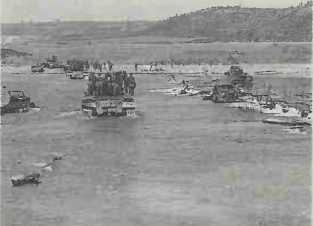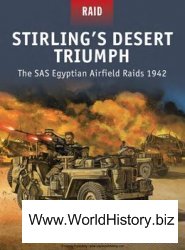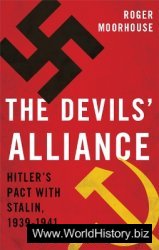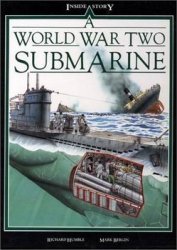Perception to full use when he succeeded Adm Noble as c-in-c, Western Approaches, November
1942. Under his direction, “support groups” of escort warships and MAC ships (later escort carriers), working closely with long-range aircraft, successfully operated against U-boat packs. RO’N.
Hoth, Gen Hermann (1885-1971). Ger. Commanded 3rd Panzer Group in invasion of Russia; from January 1942, led Fourth Panzer Army at Stalingrad and Kursk; dismissed by Hitler, late 1943.
Hovercraft. Used in Vietnam by the Americans as patrol craft in the Mekong delta, and by the British - mainly for logistic support - in Borneo. Other uses are coastal patrol, anti-submarine and counter-mine operations.
Howitzer. An artillery piece that fires shells at a high trajectory.
Hube, Gen Hans (1890-1944). Ger. Directed Italo-German defence and evacuation of Sicily, July-August 1944; led XIV Panzer Corps in defence of Italian mainland. Commanded First Panzer Army in Manstein’s resistance to Soviet winter offensive, 1944.
Hudson, Lockheed B14L, A-28, A-28A, A-29, A-29A (US, WWII). Maritime reconnaissance-bomber; crew 4/5. Development of Lockheed 14 commercial transport; to squadron May 1939. Extensively used on early photographic-reconnaissance work, clandestine operations, Air-Sea Rescue; raaf, RNZAF, later by usaf, usn. Production 2,934. Two l,100hp Wright Cyclone R-1820-G102A engines; max. speed 222mph (355kph); seven 0.303in machine guns, 1,6001b (725kg) bombs.
Hue, Battle of (1968). Nowhere during the 1968 Tet offensive did communist forces sustain their attack as long as in Hue, one of the few places where the assault force was composed largely of People’s Army of Vietnam (pavn) regulars. A force of 7,500 men entered the city on January 31, entrenched itself behind the walls of the old citadel, and held out until February 24. Constrained at first by orders not to destroy the imperial palace, the counterattack began slowly, but air and artillery strikes and house-to-house fighting later inflicted heavy damage. The fighting left over 100,000 people homeless; 2,800 bodies were found in mass graves and another 2,000 were missing, victims of communist assassinations, political vendettas and crossfires. Despite heavy losses, the communists demolished the credibility of claims that the cities were safe from attack. WST.
Huj, Battle of (November 8 1917). Immediately after the fall of Gaza, 60th (London) division (Maj Gen Shea) pursued the Turks. On November 8 1917, a Turkish column was sighted near Huj. Shea called on three squadrons of Desert Mounted Corps: 12 officers and 158 troopers under Lt Col Gray-Cheape. The cavalry charged sword in hand, dispersing the infantry and twice charging flanking batteries. Eleven guns, four machine guns and 70 prisoners were taken; all three British squadron commanders, 26 troopers and 100 horses were killed.
Hull, Field Marshal Sir Richard
(b. l907). Br. Commander 1st Armoured Division in the First and Second Battles of Coriano in September 1944; cgs, 1961; Chief of Defence Staff, 1965.
Humint. Intelligence secured by human observation.
“Hump, The” see stilwell, gen
JOSEPH; LEDO ROAD.
Hunter, Hawker P1067/P1099
(Br). Single-seat fighter/ground attack. Prototype flew July 20 1951; first deliveries to raf July 1954. Extensively used by raf and foreign air forces; produced in Belgium (255) and Netherlands (189). India acquired 160 Hunters Mk 56 and 53 FGA56As. Production: approximately 2,000. Hunter F6 had one 10,0001b (4,500kg) s. t. Rolls-Royce Avon 203 engine; max. speed 715mph (l,150kph); four 30mm cannon, 2,0001b (900kg) bombs, 24 3in rockets or two pods 24 or 37 ffar missiles.
Hurricane, Hawker (Br, WWII). Single-seat fighter/ground attack, an aircraft of exceptional versatility. Prototype flew November 6 1935; first deliveries December
1937. Eighteen squadrons by outbreak of war; four to France with AASF. Much modification and development, particularly in armament. Sea Hurricane conversions to RN 1941-43. Production 14,232. One 1.030—l,300hp Rolls-Royce Merlin engine; max. speed 340mph (544kph); eight/twelve 0.303in mchine guns, four 20mm cannon, or two 40mm cannon with 2 machine guns - eight rockets.
Hiirtgen Forest, Battle of (1944). In September 1944, US 9th Infantry Division attempted to clear Germans from dense Hiirtgen Forest, southeast of Aachen. Opposed by units of German Seventh Army, they took substantial casualties for little territorial gain. A fresh attack was launched on November 2 by US 28th Infantry Division, but in a German counterattack on the 4th the 116th Panzer Division forced an American retreat. The forest was cleared in mid-December. More than 120,000 US troops were engaged, of whom 33,000 became casualties. MS.
Hutier, Lt Gen Oskar von (18571934). Ger. Commanding Eighth Army on the Eastern Front in 1917, Hutier, with the assistance of his artillery commander, Col Georg Bruchmiiller, was largely reponsible for the development of assault tactics designed to overcome Hindenburg-Line-type defence-in-depth. “Hutier tactics” proved successful in their originator’s capture of Riga, September 3 1917, and a little later at Caporetto. Hutier was brought to the Western Front to command Eighteenth Army, achieving spectacular advances at the Somme, March 1918, where he shattered Gough’s Fifth Army, and at the Aisne, May-June 1918, but taking severe casualties at Amiens, August 8 1918. RO’N.
Hyakutake, Lt Gen Harukichi
(1888-1947). Jap. Commanded Seventeenth Army in the attempted reconquest of Guadalcanal. In 1944-45 he fought another fiercely attritional campaign on Bougainville.
Hydrogen Bomb (H-Bomb) see
THERMONUCLEAR WEAPON.
La Drang river, Battle of the
(1965). The first major engagement between American and North Vietnamese regular army units occurred in the valley of the la Drang river, which flows out of South Vietnam’s Pleiku province into Cambodia. Following an attack by the People’s Army (pavn) 32nd and 33rd Regiments on the Plei Me Special Forces camp in October 1965, elements of the US 1st Cavalry Division (Airmobile) pursued these regiments into the valley where bloody fighting ensued November 14—18. The PAVN disengaged when confronted by superior American fire power and the first direct support of ground combat by B-52s in the war. The battle marked not only the beginning of the pavn’s “big unit” warfare but also the introduction of new airmobile tactics by the Americans. WST.
Lachino, Adm Angelo (18891976). Italian. Italian Fleet Commander, succeeding Adm Cam-pioni, December 1940-September
1943. In command at the Battle of Cape Matapan, March 1941, and First and Second Battles of Sirte, December 1941 and March 1942. A generally ineffective commander; partly because constantly adjured not to hazard Italy’s capital ships.
Ichi-go see sino-japanese war.
Identification Friend or Foe (IFF). A system whereby a sensor contact can be automatically interrogated by electronic means to identify its status as a friend or foe. A transponder (transmitter/ receiver) responds to a complex coded signal from another transponder and sends back a different coded signal that identifies the contact as friendly. As engagement ranges increase in all forms of warfare, nato is trying, with some difficulty, to develop a comprehensive IFF system including a laser/radar unit for battlefield operations.
Lida, Lt Gen Shojiro (b. l888). Jap. Commander Fifteenth Army, later Burma Area Army. Announced formation of New Era Burma Government, August 1 1942; General Defence Commander, 1943.
Illustrious-class. British aircraft
Carriers: (Group 1) Illustrious, formidable, Victorious; launched 1939; 28,600 tons full load; 36 aircraft; pioneered armoured box hangar. Illustrious launched Taranto strike; pioneered radar-controlled interception from carriers; served Madagascar; Salerno landings; Indian and Pacific Oceans, 1944—45; used post-war for jet aircraft trials; scrapped
1955. Formidable at Matapan; Indian Ocean, 1942; kamikaze damage (like others of class) with British Pacific Fleet, 1945; scrapped 1955. Victorious participated Bismarck hunt; “Pedestal” Malta convoy; “Torch” landings, North Africa; with US forces in Pacific, 1943; Tirpitz strike, 1944; British Pacific Fleet, 1944—45; major conversion, 1950s; scrapped 1969. (Group 2) Indomitable; launched 1940; 29,700 tons full load; 48 aircraft; modified with extra hangar deck (as in Group 3), increasing aircraft capacity. Served Madagascar; bomb damage in “Pedestal” convoy; torpedoed Sicily; British Pacific Fleet, 1944-45; scrapped 1953. (Group 3) Implacable, Indefatigable; launched 1942; 32—
33,000 tons full load; 54 aircraft. RO’N.
Ilyushin DB-3/I1-4 (USSR, WWII). Long-range bomber; crew 3. Prototype flew spring 1936; DB-3s into service 1938. Progressively modified; final version (DB-3F) was redesignated 11-4. Mainstay of Soviet Air Force’s long-range bombing strength throughout war; also served as torpedo-bomber, transport and glider tug. Production about 6,800. Two l,100hp Tumansky M-88B engines; max. speed 267mph (430kph); 5,9521b (2,700kg) bombs, three 7.62mm or 12.7mm machine guns.
Ilyushin I1-2M3 Shturmovik
(USSR, WWII). Two-seat armoured ground-attack aircraft; entered service mid-1941 as single-seater; later modified to two-seater. Despite poor performance and handling qualities proved to be formidable tank destroyer, but no match for German fighters. Designed for ease of mass production: some 36,150 Il-2s (several subtypes) built. One l,720hp Mikulin AM-38F engine; max. speed 255mph (410kph); two 23mm or 37mm cannon, three machine guns; 1,1021b (500kg) bombs or alternative loads of rockets or antiarmour (hollow-charge) bombs.
Imamura, Lt Gen Hitoshi (1886
1968). Jap. One of Japan’s most able generals, Imamura was Vice-cos, Kwantung Army, 1936-37. Early in 1942, he led Sixteenth Army in the occupation of Java, where his comparatively benevolent occupation measures won considerable support for the Greater East Asia Co-prosperity Sphere from Indonesian nationalists. As Commander, Eighth Area Army, from November 1942, with his hq at Rabaul, Imamura was ordered to re-secure the Solomon Islands (Seventeenth Army; Hyakutake) and New Guinea (Eighteenth Army; Adachi), but despite determined efforts to reinforce Guadalcanal and other islands his forces were either evacuated or isolated by late 1943-early 1944. Imprisoned for “war crimes” in 1946 - like a number of senior Japanese commanders, the scapegoat for the excesses of junior officers - Imamura was paroled in 1954. RO’N.

UN forces on the Imjin river, Korea
Imjin river, Battle of the (1951). Occurred during the Korean War 35 miles (56km) north of Seoul. On April 22-25 1951, during the first phase of their spring offensive, the Chinese attacked the 29th British Infantry Brigade which was holding a 12,000yd (11,000m) front along the Imjin river. The Brigade was deployed with 1st Battalion the Gloucestershire Regiment to the left and 1st Battalion the Royal Northumberland Fusiliers to the right. The 1st Battalion the Royal Ulster Rifles was in reserve. An attached Belgian battalion was holding a position north of the river. The Chinese attack began on the night of April 22.




 World History
World History

![Road to Huertgen Forest In Hell [Illustrated Edition]](/uploads/posts/2015-05/1432477693_1428700369_00344902_medium.jpeg)







